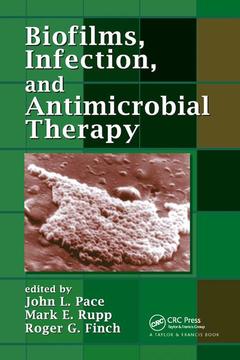Description
Biofilms, Infection, and Antimicrobial Therapy
Coordinators: Pace John L., Rupp Mark E., Finch Roger G.
Language: English
Subjects for Biofilms, Infection, and Antimicrobial Therapy:
Keywords
Biofilm Formation; Biofilm Infection; IMDs; Staphylococcal Biofilms; MBEC; Antimicrobial Resistance; Biofilm Matrix; Cystic Fibrosis Patients; Abiotic Surface; Vancomycin; Resistant Enterococci; Foreign Body Infections; Epidermidis Strain; PJI; Epidermidis RP62A; Alginate Lyase; Conditioning Films; Biofilm Susceptibilities; Candida Biofilms; Biomaterial Surface; Epidermidis Isolates; Coagulase Negative Staphylococci; Device Related Infections; Rabbit Endocarditis Model; Log CFU; Persister Cells
Publication date: 10-2019
· 15.6x23.4 cm · Paperback
Publication date: 08-2005
494 p. · 15.6x23.4 cm · Hardback
Description
/li>Contents
/li>Readership
/li>Biography
/li>
Rather than existing in a planktonic or free-living form, evidence indicates that microbes show a preference for living in a sessile form within complex communities called biofilms. Biofilms appear to afford microbes a survival advantage by optimizing nutrition, offering protection against hostile elements, and providing a network for cell-to-cell signaling and genetic exchange.
Biofilms, Infection, and Antimicrobial Therapy provides an in-depth exploration of biofilms, offering broad background information, as well a detailed look at the serious concerns to which biofilm-associated infections give rise.
Prosthetic device infections, such as those involving artificial heart valves, intravascular catheters, or prosthetic joints, are prime examples of biofilm-associated infections. With the increasing use of such devices in the modern practice of medicine, the prevalence of these infections is expected to increase. Unfortunately, one of the most troubling characteristics of microbes found in biofilms is a profound resistance to antimicrobial agents.
As biofilm-associated infections are particularly difficult to treat, they result in significant mortality, morbidity, and increased economic burden. Clearly, a better understanding of the pathogenesis of these infections and improved means for prevention and treatment are urgently needed!
InBiofilms, Infection, and Antimicrobial Therapy, Drs Pace, Rupp, and Finch assemble the contributions of more than 50 of the world?s leading authorities on microbial biofilms who present recent findings on antibacterial tolerance and bacterial persistence associated with biofilms and discuses the implications of those findings with regard to human health. They explore the molecular mechanisms of bacterial adherence, biofilm formation, regulation of biofilm maintenance, and cell-to-cell communication and present the latest information on various treatment protocols that should aid physicians in the treatment o
Biofilms—Background, Significance, and Roles of Catheters and Indwelling Devices. Biofilm-Forming Pathogens. Emerging Issues, Assays, and Models. Overview of Anti-Ifective Agents and Clinical Therapy.
These books may interest you

Biofilms and Veterinary Medicine 158.24 €



